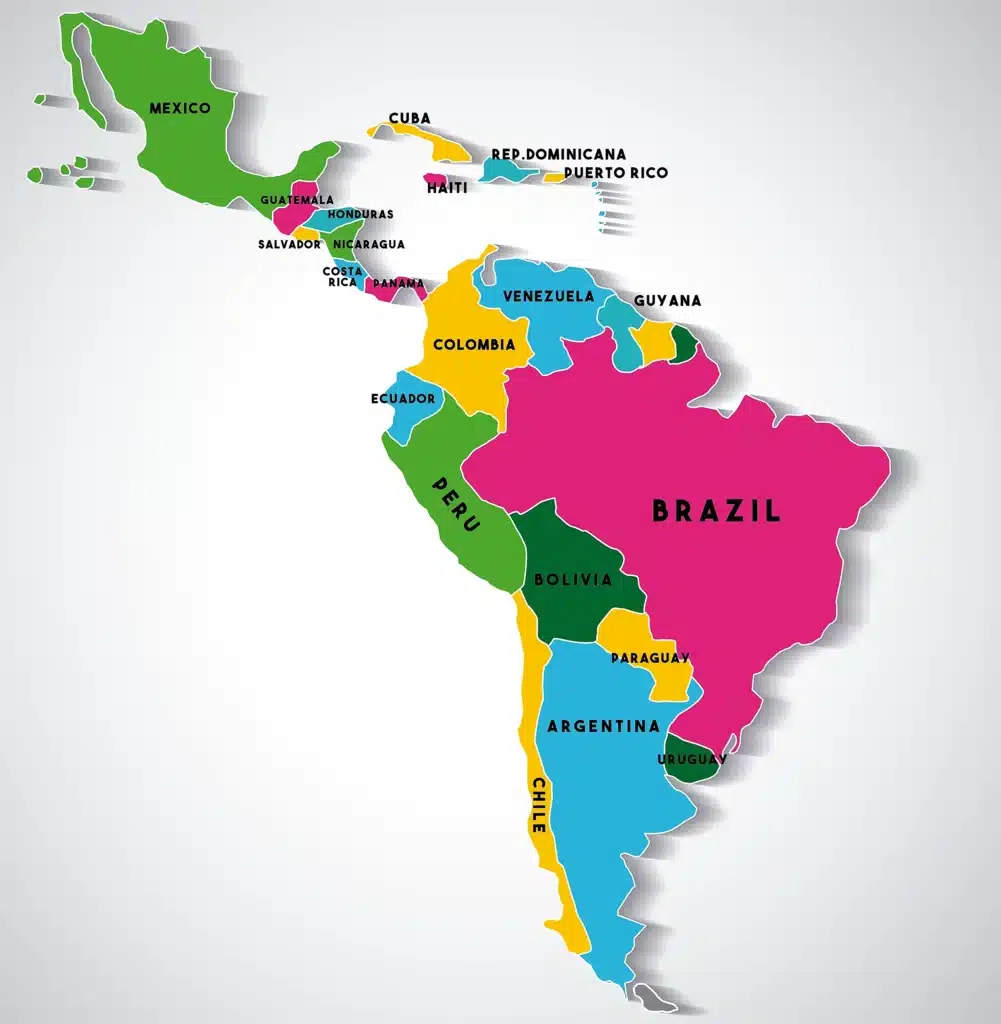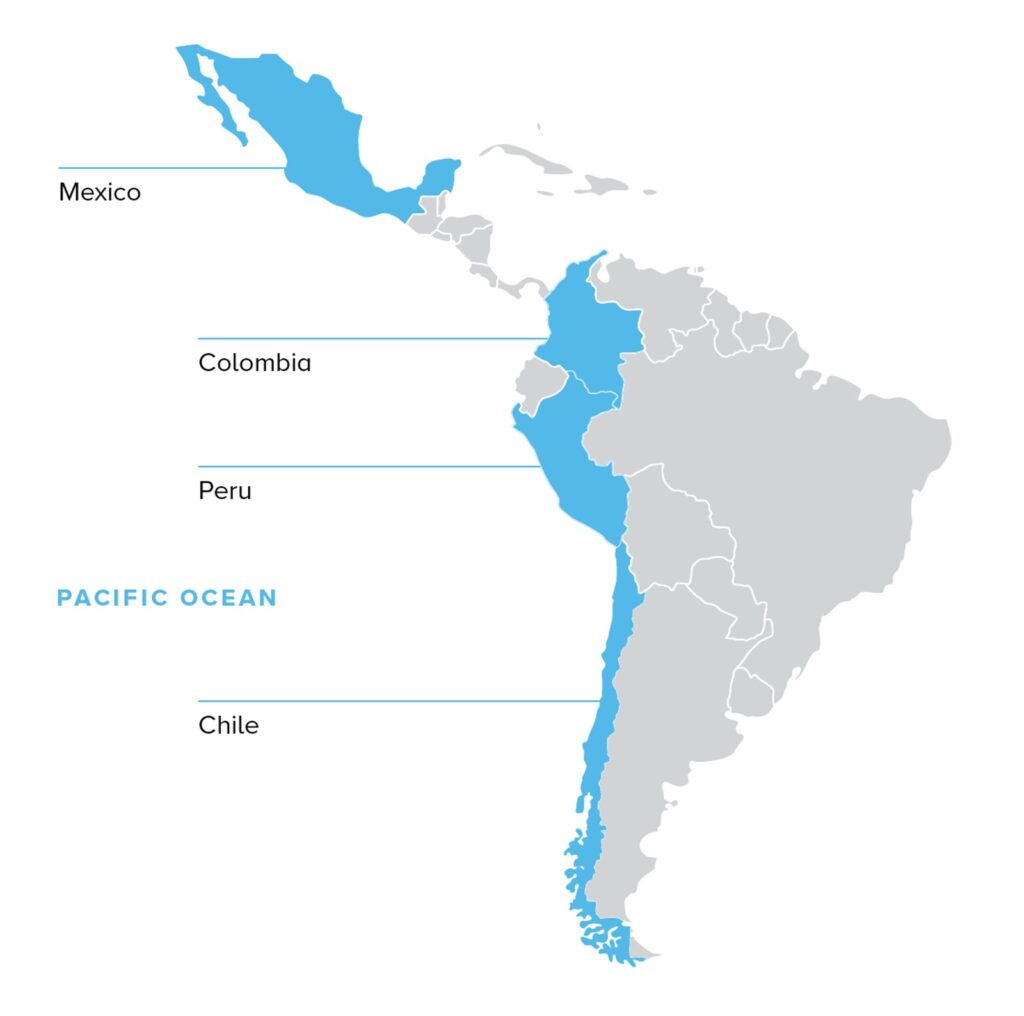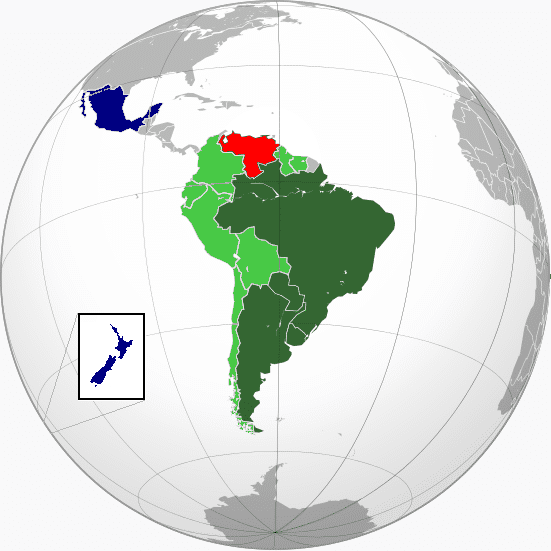Latin America is generally understood to consist of the entire continent of South America in addition to Mexico, Central America, and the islands of Caribbean whose inhabitants speak a Romance language such as Spanish, Portuguese, and French.

India-Latin America: Background
- Both the LAC (Latin American and Caribbean) countries and India had found themselves in very different situations post-independence.
- LAC countries came under the influence of US hegemony, while India started the Non-Aligned Movement and later signed a friendship treaty with Soviet Union. This had created a wedge between the two.
- Moreover, LAC countries did not act as a unit and were grappling with political instabilities where some countries showing capitalist tendencies while others leaning towards socialism. India’s closed economy didn’t help matters either.
- India and Latin American nations were both colonies of European powers. After achieving independence, both adopted socialist policies, which did little to enhance relations.
- Many Latin America and the Caribbean (LAC) countries joined the Non-Aligned Movement (NAM).
- India also supported LAC countries against US interventions in the UN and other multilateral gatherings, but this did not address the deficit in the relationship.
- With the emergence of democracies in the region post-Cold War and India’s opening up of its economy, several opportunities for growth of trade and commerce were created.
- India’s ties with certain Latin American nations are longstanding and Mexico was the first Latin American country to recognize India after its independence in 1947.
India’s Interests in Latin America
- Economic Interests – Latin America is very rich in minerals such as copper, lithium, iron ore, gold, and silver.
- gives India an opportunity to increase investments for their extraction as well as for their imports at cheaper rates.
- India’s exports to Latin America amounts to $13.6 billion in 2018-19.
- Strategic Interests – The region is very important for India in order to achieve its global ambitions.
- such as pursuing permanent membership of the UNSC, the NSG and at various other negotiations like climate change, terrorism, trade, etc.
- Energy Security – India sources about 15% of its crude oil from Latin America countries.
- Latin America has huge reserves of crude oil (20% of global reserves).
- Latin America is also an important partner in the India led International Solar Alliance.
- Food Security – Latin American region is five times the size of India with only half as much population.
- India can utilize this fertile land to improve agriculture and reduce its import costs, as India is currently importing pulses and oil seeds from many of African and Southeast Asian countries at very high costs.
Why is Latin America important for India?
- In 2016-17, India exported more to Mexico ($3.5 billion) than to neighbours such as Thailand ($3.1 billion), Myanmar ($1.7 billion) and Iran ($2.4 billion) or traditional trade partners Russia ($1.9 billion) and Canada ($2 billion).
- India’s trade with the Dominican Republic ($900 million) was more than the trade with Portugal, Greece and some other European countries.
- India beat China in export of pharmaceuticals to Latin America. India’s exports were $651 million in comparison to China’s $404 million in 2016. In fact, in the last five years, India has been exporting more pharma to Latin America than China.
Areas of Cooperation
- Economic Cooperation – India imports large quantities of hydrocarbons from Venezuela, Mexico, Colombia, and Brazil; edible oils and sugar from Brazil and Argentina; copper and precious metals from Chile and Peru; wood from Ecuador, etc.
- India is one of the largest suppliers of IT services to Latin America
- In the last five years, India has been exporting more pharma to Latin America than China.
- Preferential Trade Agreement (PTA) was signed with MERCOSUR in 2004 – to expand and strengthen the existing relations between MERCOSUR and India and promote the expansion of trade by granting reciprocal fixed tariff preferences.
- Investment – Latin American firms have invested about a billion dollars in India in areas such as soft drinks, multiplexes, theme parks, and auto parts.
- Development Assistance – India had recently announced 14 million US dollar grant for community development projects in CARICOM & 150 million line of credit for solar, renewable energy and climate change related projects.
- Global Partnership – India is cooperating with Brazil at platforms like BRICS, IBSA which has provided an alternative platform for developing countries and reduces their dependence on existing institutions controlled by west.
- Military Cooperation – India’s DRDO and Brazilian aircraft company Embraer have collaborated to develop and produce airborne radar platforms.
Pacific Alliance
- The Pacific Alliance is a Latin American trade bloc, formed by Chile, Colombia, Mexico and Peru, which all border the Pacific Ocean.
- These countries have come together to form an area of integration with the purpose of ensure a complete freedom in the movement of goods, services, capital, and people.
India’s Role in Pacific Alliance
- India enjoys an observer status at the annual summit of Pacific Alliance
- A key area for collaboration for PA and India could be understanding the impacts of El-Nino and its common approach against this weather pattern. Countries dependent upon agriculture and fishing, particularly those bordering the Pacific Ocean, are the most affected by El-Nino. All PA states have coasts along the Pacific.
- PA is turning out to be an integrated market and it opens up opportunities for India in SMEs sector, trade facilitation, science & technology innovation and export of Indian pharmaceutical products.

MERCOSUR
- The Southern Common Market, commonly known by Spanish abbreviation Mercosur, and Portuguese Mercosul, is a South American trade bloc established by the Treaty of Asunción in 1991 and Protocol of Ouro Preto in 1994.
- Its full members are Argentina, Brazil, Paraguay, and Uruguay.
- Venezuela is a full member but has been suspended since 1 December 2016.
- Associate countries are Bolivia, Chile, Colombia, Ecuador, Guyana, Peru, and Suriname.
- Headquarter : Montevideo (Uruguay)
- Brazil has asked India to expand its commercial and multilateral footprints in South America by expanding its relation with MERCOSUR.

Challenges in India-Latin America Relation
- Lack of Uniform approach – India has good relations with countries like Brazil, Mexico, Chile but other countries lag behind.
- FTA talks with MERCOSUR has been stalled due to differences amongst the members of the grouping.
- Though trade in commodities continues to grow and has reached $46 billion in 2012-13, but it is nothing compared to the Chinese trade.
- Regional politics – Rivalries between countries like Brazil and Argentina for regional dominance is also affecting India’s relations with the region.
- For instance, while India and Brazil are part of the G4 seeking the UNSC membership, Argentina is part of the Coffee Club (in opposition to expansion of UNSC).
- Poor Connectivity – geographical distances have impeded trade between India and Latin America.
- Lack of direct shipping service from India to Latin America; difficulty in shipping heavy commodities and perishables.
- Whereas China has direct shipping links through the Panama Canal, giving it an upper hand.
- Brand awareness of Indian products in Latin America is abysmal compared to European, US, Chinese, Japanese or Korean industry.
Way Forward
- The absence of political disagreement with Latin America leaves the field open for positive engagement. The bridges we build will endure and enable Indian business and other interests to cross over and operate in that region with greater ease. The need to engage the LAC region bilaterally, collectively, and concertedly, at all levels, as we have done with Africa and South-East Asia, is evident.
- India and Latin America need to better understand each other’s political reality, endowments, capabilities, and priorities, beyond the experience of transitory diplomats.
- Latin America acts through multiple layers of regional and sub-regional organisations, so arguably India needs to take the lead in identifying and activating the principal actors and forums.
- Political initiatives need to be supported by economic and social interaction
- Agreements should be made for investment protection, avoidance of double taxation, extradition, immigration, lines of credit, elimination of regulatory hurdles, etc.
- India should increase its diplomatic presence in the region, promote Latin American studies, invest in shipping industries, conclude PTAs (Preferential Trade Agreements) and FTAs (Free Trade Agreements) at the earliest with different countries and groupings in the region.
The Indian elephant has already engaged the tigers of Asia. It is now the turn of the pumas of the Pacific.
